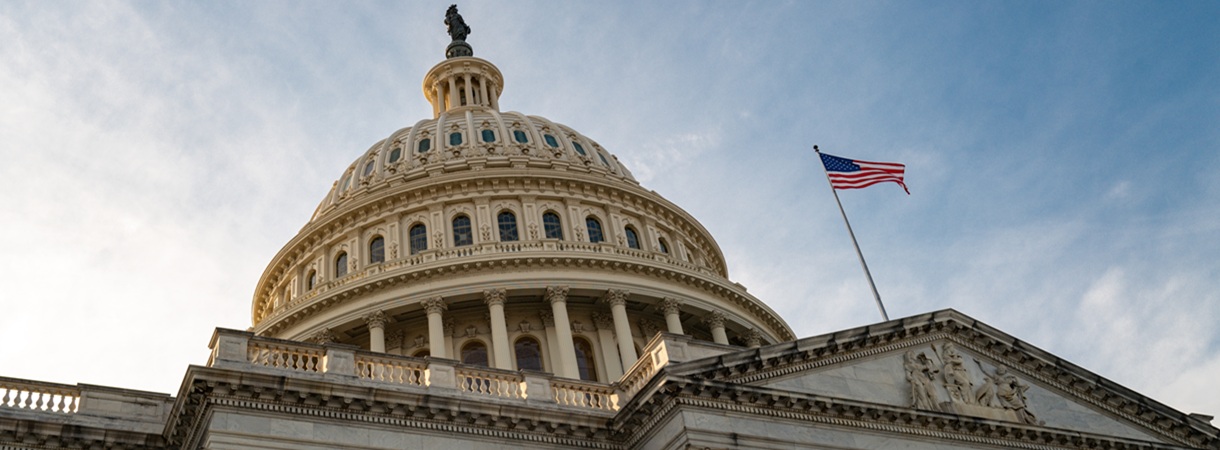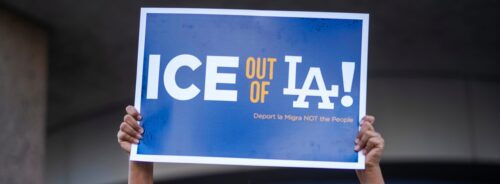On July 15, members of Congress reintroduced what has sadly become an increasingly rare bit of legislation: an immigration reform bill aimed at addressing large-scale systematic problems with our immigration system, which has not received any major update since the 1990s. The “DIGNIDAD (Dignity) Act” represents one of the most sweeping attempts to modify the immigration system that has been proposed in years.
The bill is grounded in the principle of trading increased enforcement (primarily at the border) for changes to the legal immigration system and a path to legal status for undocumented immigrants who are long-time residents of the country.
While many recent attempts to reach similar compromises have been much more limited, the Dignity Act would provide a path to permanent legal status — but notcitizenship — for nearly all undocumented immigrants who have been in the United States since December 31, 2020. In exchange, the bill would significantly overhaul how asylum seekers are processed at the border, mandate national E-Verify, and create new criminal penalties for certain immigration violations.
Though the fate of the bill remains uncertain in the current GOP-controlled Congress, it is a sign that bipartisan compromise is still alive among some factions of both parties. As Trump ramps up his mass deportation operations, the American public has again turned in favor of immigration and in providing a path to permanent legal status for the millions of undocumented immigrants present in the country. If the public’s desire for immigration reform ever has a chance of passing Congress, compromises like those in the Dignity Act may prove the starting point for future negotiations.
What Is the Bill’s Primary Path to Permanent Legal Status for Undocumented Immigrants?
When first introduced in 2023, the bill created a new “Dignity” Program, available to any undocumented immigrant who had lived in the country for at least 5 years. After completing this program, individuals could transition to the “Redemption Program” which offered a path to a green card, and then eventual citizenship, once the U.S. Government Accountability Office certified that the border was “secure.”
In its new form, the bill eliminates the “Redemption Program” and replaces it with “Dignity Status.” This new status would be a form of non-immigrant status, one which offers the same protections from deportation and ability to work and travel as a green card, but without a direct path to become a U.S. citizen or to sponsor family members to immigrate here.
Eligibility for the Dignity Program remains largely the same as in the prior bill. Individuals applying for the program would have to come forward, admit their unlawful presence, prove they have no serious criminal record by passing a background check, and pay $1,000. Once the initial application was approved, the person would be given permission to remain in the U.S. for seven years. Individuals who were not eligible for the program would be given a 12-month period to leave the United States without being subject to the 3- and 10-year bars to reentry that currently apply to most undocumented immigrants.
During the seven years of the Dignity Program, the person would have to report to the Department of Homeland Security (DHS) every two years, provide testimony of “good standing in their community,” and pay an additional $6,000 in installments of at least $1,000 per visit.
Fees and restitution paid under these programs would be used to fund the national deployment of E-Verify and would fund job training and apprenticeship programs for American workers. The bill creates a new national grant program, operating with the cooperation of states and localities, to disburse this new funding and create opportunities for Americans to reskill or learn new trades. Thus, as envisioned, the fees could lead to the creation of a national network of federally supported jobs and training programs for American workers.
The Dignity Program would also include a work and study requirement, with exceptions available for those with dependents and the elderly. That would come along with an additional 1% tax levy, which is offset by an exemption from paying FICA taxes (social security, Medicare), as Dignity Program beneficiaries would be banned from receiving any federal benefits.
Once a person successfully completes the Dignity Program, they would transition to “Dignity Status.” Dignity Status would be a form of non-immigrant status which lasts for seven years and can be renewed indefinitely. Individuals with Dignity Status would be able to travel outside the country, work legally, and renew their status potentially for the rest of their life. Like individuals with green cards, those with Dignity Status could not have that status taken away except through a final order of removal issued by an immigration judge.
However, individuals on Dignity Status would not be eligible to apply for naturalization to become a U.S. citizen, could not sponsor family members to immigrate here legally, and would not be eligible for any means-tested federal benefits.
The change from a pathway to citizenship to a pathway to a permanent non-immigrant status will undoubtedly be seen as a blow to immigrant advocates. However, it may assuage the concern of some Republican supporters, who do not back a path to citizenship for the broader undocumented immigrant population.
What Other Paths to Legal Status for Undocumented Immigrants Does the Bill Create?
When originally introduced, the bill contained three separate paths to green cards unrelated to the Dignity Program, including the DREAM Act for undocumented immigrants brought here as youth, the American Promise Act for individuals previously granted Temporary Protected Status (TPS), and a provision that would have provided a pathway to a green card for undocumented immigrants working in farm labor.
In the 2025 version of the bill, only the DREAM Act remains as a separate path to a green card. The farmworker provisions have been excised completely. The protections for TPS have been reduced to a provision that individuals going through the Dignity Program do not have to pay the $7,000 fee if they previously had TPS.
Under the version of the DREAM Act in the bill, individuals who arrived before age 18 could obtain a green card if they have a college or graduate degree, serve in the military for at least three years, or are employed and working for at least four years. They would also have to learn English and pass a civics test. An analysis of a previous version of the DREAM Act found that it could provide a path to a green card for as many as two to three million people.
What Changes to Immigration and Border Enforcement Does the Bill Make?
When first introduced, the Dignity Act provided tens of billions of dollars to the Border Patrol to build new border barriers, hire agents, and deploy technology. With the passage of the One Big Beautiful Bill Act on July 4, which provided much of that funding, the bill no longer provides additional money. However, it still makes a number of significant changes to the border enforcement process. Criminal penalties for illegal border crossing would increase significantly, and the bill creates new crimes for “illicit spotters” who track Border Patrol movements for smugglers. In addition, DHS would be granted new legal authority to waive certain legal requirements prior to constructing and deploying new border walls and technology. Along with these changes to immigration enforcement, the bill would mandate E-Verify be used across the country, with severe penalties for employers that do not adopt the program or fail to verify the immigration status of their workers. The bill also requires that any sponsor of an unaccompanied child be put through a full biometric background check.
Beyond the border, the bill would add new penalties for asylum fraud and make it easier for U.S. Citizenship and Immigration Services to deny asylum applications when they detect fraud. Individuals found to have submitted materially fraudulent applications could be subject to federal prison.
What Changes to Asylum Processing Does the Bill Make?
The bill’s largest changes to border processing are related to asylum. The bill mandates that DHS construct at least three large “humanitarian campuses” along the southern border, where asylum-seeking adults and families would be taken after apprehension.
These campuses would be staffed by multiple federal agencies, as well as nonprofit organizations, social workers, case managers, and legal support, and would purportedly be less carceral than family detention centers, although families would still not be permitted to leave in most circumstances. The bill does provide that anyone in these centers can have access to counsel and even incentivizes lawyers to come work there by providing that any lawyer who works at a humanitarian campus for four years can have 75% of their federal law school student loans forgiven.
At these “humanitarian campuses,” migrants seeking asylum would be given 72 hours to rest following an apprehension by Border Patrol or their arrival at a port of entry. During that time, they would be given mandatory background checks. DHS would also use the opportunity to gather DNA to test any claimed familial relationship. Those seeking protection would then be provided a legal orientation, followed by a credible fear interview within the first 15 days.
Any individual who passed a credible fear interview would be then transferred to an asylum process, with the goal of completing this process within 45 days. These claims would initially be heard by asylum officers, not immigration judges, who would only hear cases which are “complex or uncertain.”
In order to determine which cases are complex and uncertain, the Dignity Act provides that each asylum claim would be heard by two asylum officers simultaneously. If both agreed that person qualified for asylum, the person would win asylum on the spot. If both agreed that the person did not qualify for asylum, their case would be denied. If there was a disagreement between the asylum officers, then the person would be referred to an immigration judge to handle the more complex or unusual cases.
Individuals who were denied at this initial stage would have only one chance to appeal the decision before a different panel of two asylum officers, who would be required to render a decision within seven days. If again denied, the person would be issued a final order of removal and be barred from seeking any judicial review of that decision. If the second panel of asylum officers believed that the first panel had made an error, the case would be referred to an immigration judge to review what had proven to be a complex or uncertain case.
Only if a person’s case was deemed complex or uncertain and transferred to an immigration judge, or if the person met the definition of a “vulnerable population,” would a person be eligible to be released from the humanitarian campus and allowed to apply for asylum in normal removal proceedings in front of an immigration judge. Anyone released this way would be subject to mandatory electronic monitoring and be required to check in with the government on a weekly basis. Failure to comply with these terms would lead to the issuance of an automatic denial of asylum and an order of expedited removal.
There would also be a new program for individuals to be “pre-screened” for asylum in Latin America. Those deemed to have presented “overwhelming evidence” of eligibility for asylum would be able to enter the United States legally on a new type of visa, which would be capped at the total number of refugees authorized to enter each year.
What Changes to Legal Immigration Would the Bill Make?
The bill would also make a number of changes to the legal immigration system, several of which are aimed at eliminating lengthy visa backlogs. First, the bill would cap visa backlogs at a maximum of 10 years, with a transition period through 2035 aiming to reduce the strain on consulates. After 2035, no visa could become backlogged for longer than 10 years. Currently, backlogs are so severe that some people are expected to wait over 100 years to become eligible for a visa — effectively meaning it will never come.
The bill adopts a number of other significant changes to address the problem of visa backlogs. It would double “per-country caps” on visas from 7% to 15%, with the potential to significantly reduce delays for nationals of countries like Mexico, China, India, and the Philippines. The bill would also effectively double annual employment-based visas, by no longer counting spouses and children of people granted employment-based immigrant visas against total visa caps. Finally, the bill would fix the problem of “documented dreamers,” where children of those present on temporary work visas (like H-1Bs) are forced to self-deport when turning 21.
The bill also makes miscellaneous changes to existing visa categories. That includes expressly permitting student visa-holders to have a “dual intent,” permitting them to seek to remain in the U.S. legally after college. In addition, individuals seeking “O” visas for “extraordinary ability” would be able to demonstrate their qualifications through having any STEM PhD, as well as those with PhDs in healthcare or medicine. There would also be a new “family purpose” non-immigrant visa, intended to address denials of tourist visas for many loved ones of U.S. residents, which would allow U.S. citizens and lawful permanent residents to sponsor a relative to come visit for 90 days for a social occasion such as a wedding or funeral. The bill also creates a streamlined path for naturalization through service in the U.S. military.
Finally, the bill addresses backlog reduction and the need to hire up to process the flood in applications that would come from these changes by providing $2.56 billion for USCIS backlog reduction, $852 million for the State Department, and $225 million for the Department of Labor.
What’s Next?
After the bill’s introduction, it remains unclear whether it will ultimately make it to the House Floor. Regardless of whether it becomes law or not, and even though there’s a lot to like and dislike on both sides, it’s worth highlighting the fact that there are still good-faith efforts to reach a compromise on a subject that desperately needs one.
 The American Immigration Council is a non-profit, non-partisan organization.
The American Immigration Council is a non-profit, non-partisan organization. 


